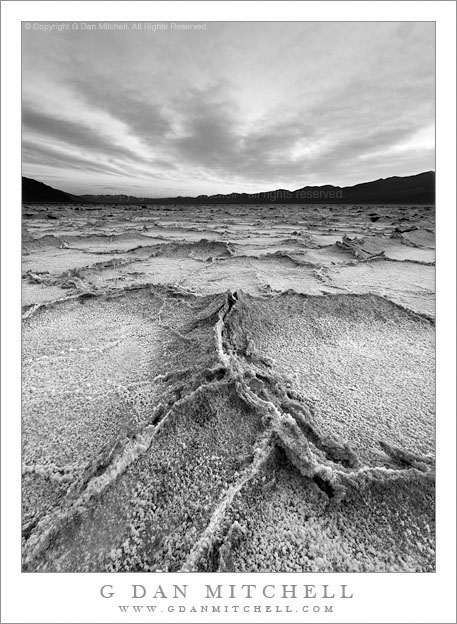During the past year or two I had written the majority of an extensive guide to photographing in Death Valley National Park and some of the surrounding areas, and shared it at this web site. It was chock-full of the names of places and descriptions of how to get to them and specific suggestions regarding how they might be photographed – along with a few disclaimers and warnings about dangers including focusing too much on bagging photographs of icons, endangering certain fragile things in the park, and so forth.
I recently took this guide down, with the intention of writing a new one that I hope will be more useful to those who are looking for a bit of a deeper understanding of the place and how it might be photographed, perhaps at the expense of providing that quick list of where to go and how to get there.
Every so often friends remind me that there are ethical risks in sharing too much detailed information in the wrong forums, and recently one friend mentioned this relative to a post about a particular area I had photographed that is easily accessible but not yet overrun. As result I began the process of going through some previous posts and editing descriptions to offer details only when it seemed important in the context of the photograph. Then I started thinking a bit more about the content of the my existing guide to photographing the park. Even though I had worked to “sanitize” the descriptions in the old guide – removing many of the references to exact spots and so forth – and of including exhortations to protect the place, I began to think that I was not necessarily doing photographers a big favor by offering a guide that was primarily organized along the lines of “places to go,” and which might encourage people to go “bag a shot” of these places rather than looking a bit deeper.
Some may ask, “Why not tell people the best places?”
- Plenty of other people have already written guides to the places. In the end, I probably don’t really have a lot to add to this pool of information. If you want to know the names of icons and where to find them you can certainly find this information elsewhere.
- While many of us begin by thinking that the goal is to photograph the “famous places” – and, frankly, that is not a bad way to start – eventually I realized that it was the process of discovering my own orientation to the park that brought greater pleasure and rewards. I don’t want to encourage others to miss out on that experience.
- Some of the places are wonderful largely because of their remoteness and solitude. In fact, the immense solitude of Death Valley is one of the most powerful and rare things it has to offer, and there are still many places and times to find this. I don’t want to accelerate the loss of this valuable commodity.
- While many areas of the park might seem too rugged to be damaged much by our passage, there are fragile things here that cannot withstand the presence of too many people – and there are plenty of examples of things that have already been damaged. While it isn’t my goal to keep people away from the park, I certainly don’t want to accelerate the degradation of these resources by unnecessarily encouraging more people to go to these places.
So, I’m offering this post as both an explanation of where the old Death Valley guide went, and as a promise to get to work on the document that will replace it. My plan is to speak in more general terms about what it means to photograph in the park and about how to approach it as a photographic subject – and to do so in a way that may offer something useful to all who want to seek out the rewards that come from developing a deeper relationship with this land.
G Dan Mitchell is a California photographer whose subjects include the Pacific coast, redwood forests, central California oak/grasslands, the Sierra Nevada, California deserts, urban landscapes, night photography, and more.
Blog | About | Flickr | Twitter | Facebook | Google+ | 500px.com | LinkedIn | Email
Text, photographs, and other media are © Copyright G Dan Mitchell (or others when indicated) and are not in the public domain and may not be used on websites, blogs, or in other media without advance permission from G Dan Mitchell.


